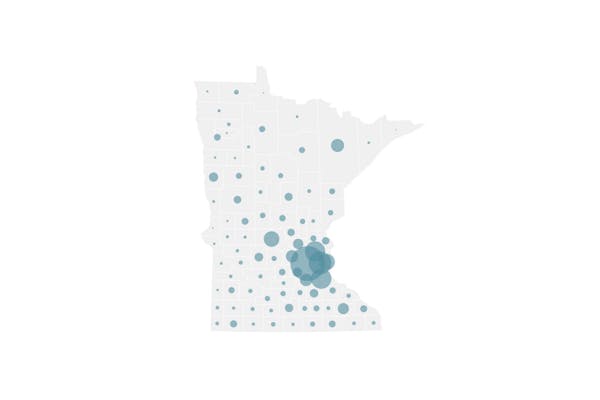Gov. Tim Walz hinted Monday that he plans to extend the current stay-at-home order to reduce the spread of the COVID-19 virus in Minnesota, but with a tailored approach that allows some businesses to resume normal operations.
While cases of COVID-19 continue to increase — with 30 deaths and 986 confirmed cases in the state so far — Walz said there are encouraging signs, including a confirmed case rate of around 17 per 100,000 people in Minnesota that is the lowest among all states.
"We're not resting on those laurels," the governor said. "We're preparing for what will come — a surge to our hospitals, a burden on those emergency rooms, and the risk [of infection] to our neighbors."
Walz acknowledged the risk of scaling back any COVID-19 mitigations that are working — especially with a presumed surge in cases in the weeks ahead that could overwhelm hospitals. The governor said he is conducting a "sector by sector" analysis of businesses that could reopen after the current stay-at-home order expires Friday without jeopardizing the state's progress in limiting COVID-19 cases.
"Are there things that we can do that would keep it just as safe, would not add to the transmission rate, would not put at-risk populations at risk, and yet would allow some economic activity to continue on? That's what I'm trying to strike the balance on," Walz said.
The idea of a scaled-back order came Monday amid encouraging news for Minnesota, including progress by Mayo Clinic and the University of Minnesota in developing antibody tests that identify when people have recovered from COVID-19 and may no longer be at risk of contracting or spreading the virus. Mayo started this testing on Monday. Both institutions also secured funding on Monday to test a blood pressure drug as a possible treatment of COVID-19.
Forecasting by the University of Washington's Institute for Health Metrics and Evaluation also dropped the predicted COVID-19 death toll in Minnesota in the next four months from 932 to 625. The institute projected no dates on which the state's hospitals would run out of ventilators — which are critical for keeping patients with severe COVID-19 cases breathing.
U.S. stock values soared Monday on hopes that case rates of COVID-19, though still increasing, were not rising at the exponential rate that would be expected at this stage of the pandemic. The economic pain of the pandemic and the stay-at-home strategies to limit its spread have showed in the 342,000 Minnesotans who have applied for unemployment benefits.
Health officials cautioned against overconfidence. Minnesota having the lowest COVID-19 case rate is partly a function of limited diagnostic testing by the state's public health lab due to a supply shortage, though Walz said other states have low testing rates as well.
State Health Commissioner Jan Malcolm said she also is concerned that new guidance from the U.S. Centers for Disease Control and Prevention on wearing masks in public could create false security and less compliance with stay-at-home guidelines.
"We just want to keep reinforcing that people who are sick need to be staying at home and isolating," she said, "not feeling like it's safe to go out in the community just because they're wearing a mask."
Minnesota also has outbreaks of at least one COVID-19 case in 33 long-term care facilities — a particular concern because people who are older or have underlying health conditions are at highest risk of severe illness.
Pre-existing medical conditions have been found in 47.9% of confirmed COVID-19 cases with complete medical histories in their records. But among those hospitalized, the rate jumped to 76.8%.
Researching risk factors
The median age of the 30 Minnesotans who died from COVID-19 is 86. The state has detailed health data on 28 of those victims, and 27 had underlying health conditions such as diabetes.
State health epidemiologists are now reviewing COVID-19 cases to see what other characteristics predisposed people to have more severe symptoms or need hospitalizations, said Kris Ehresmann, state infectious disease director. Obesity might be a risk factor, for example.
A majority of Minnesota's confirmed cases are among women, but that appears to be a result of the state lab's limited testing that includes health care workers and long-term care residents, who are more likely to be women.
The state's testing capacity expanded in the past week when labs at the University of Minnesota Medical Center and HCMC started testing on their own. Nearly 200 cases have been confirmed in the past three days alone.
On Monday, 115 people were hospitalized with COVID-19, and 57 were in intensive care. Among confirmed cases, 470 people have recovered and are no longer subject to isolation restrictions.
Initially, the majority of cases in Minnesota occurred in people with recent histories of travel to other nations or states in which the coronavirus had been spreading. Now, 34% of cases are due to unknown sources within their communities, meaning that the virus is spreading widely in the state.
Ehresmann said there have been a couple of instances in the state of large gatherings that helped spread infections within families, but no known "super-spreader" events like the choir practice in Washington state in which one asymptomatic person spread the coronavirus widely to others.
Jeremy Olson • 612-673-7744
Body camera video shows Minnetonka man shooting at deputies several times before dying in firefight
Charge: Driver going 77 mph ran red light, fatally hit man crossing St. Paul street and kept going
Minnesota Senate GOP files ethics complaint against Sen. Nicole Mitchell
High school archer focuses on target: another national championship

